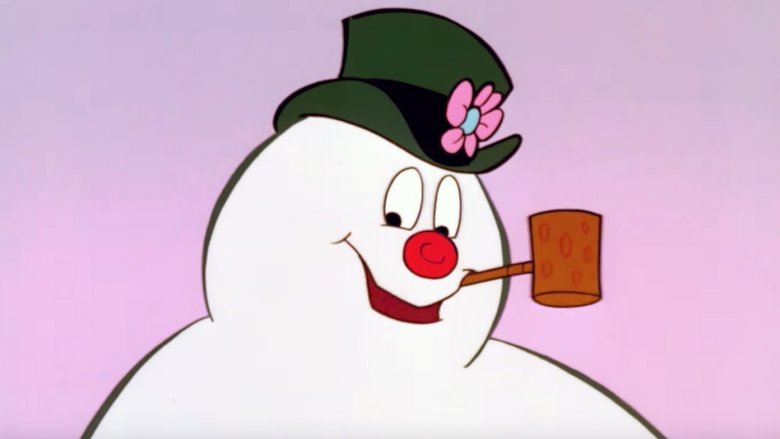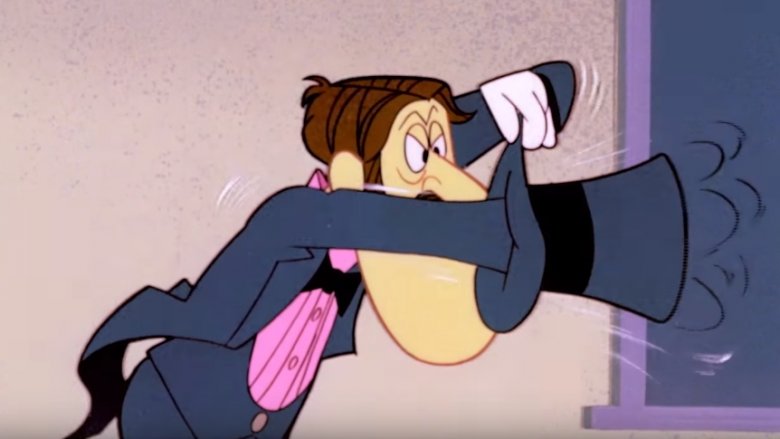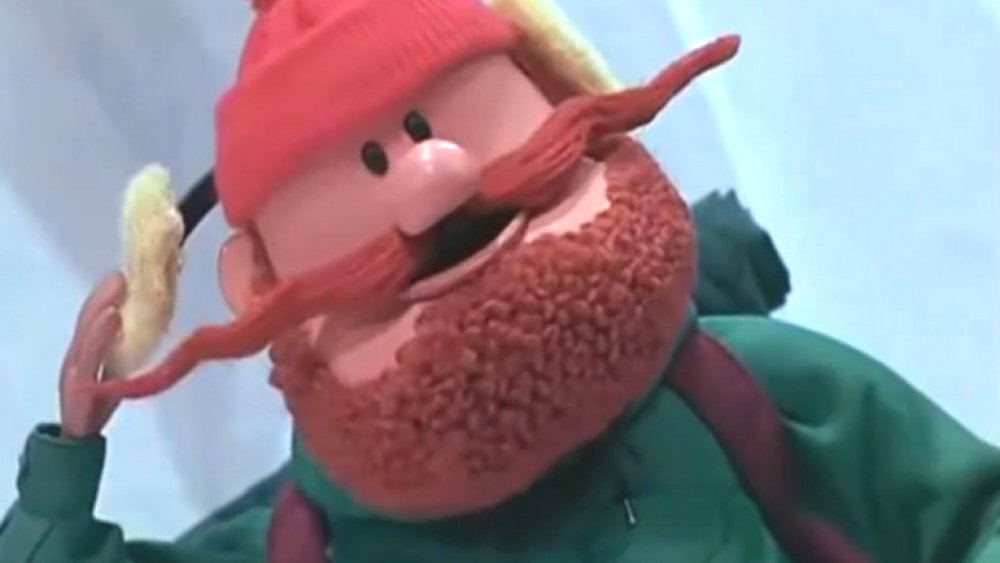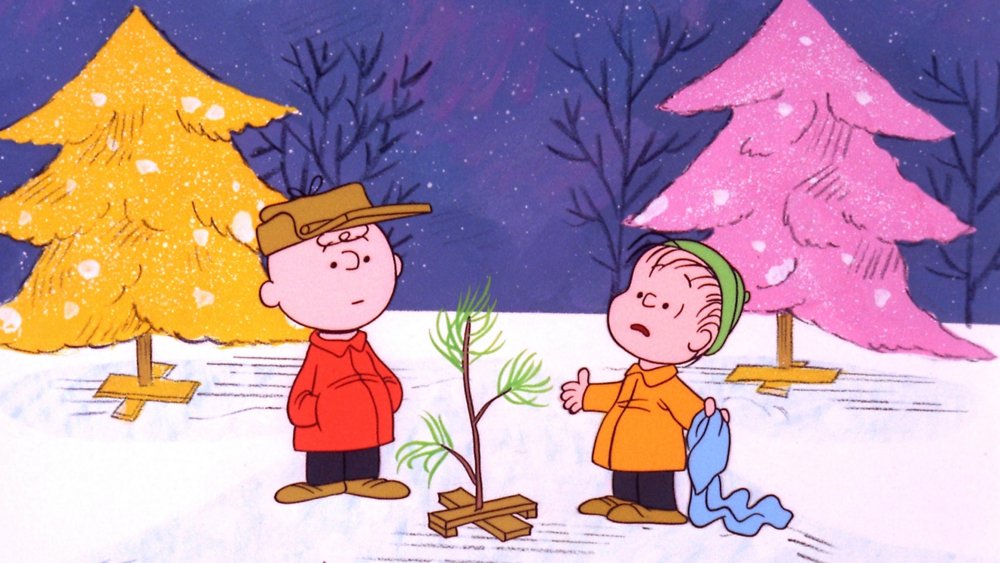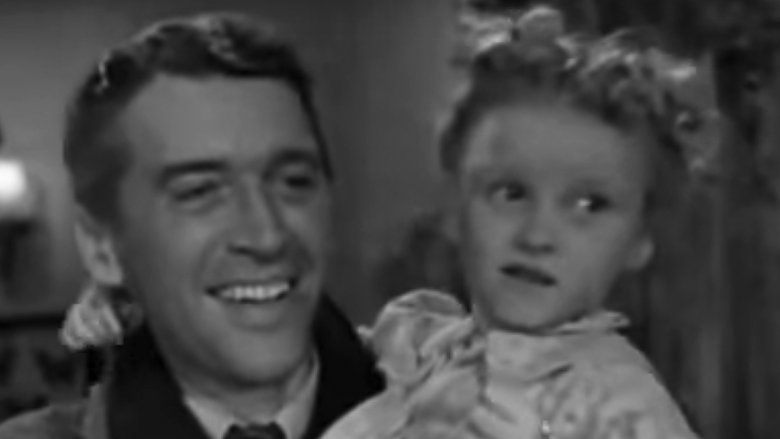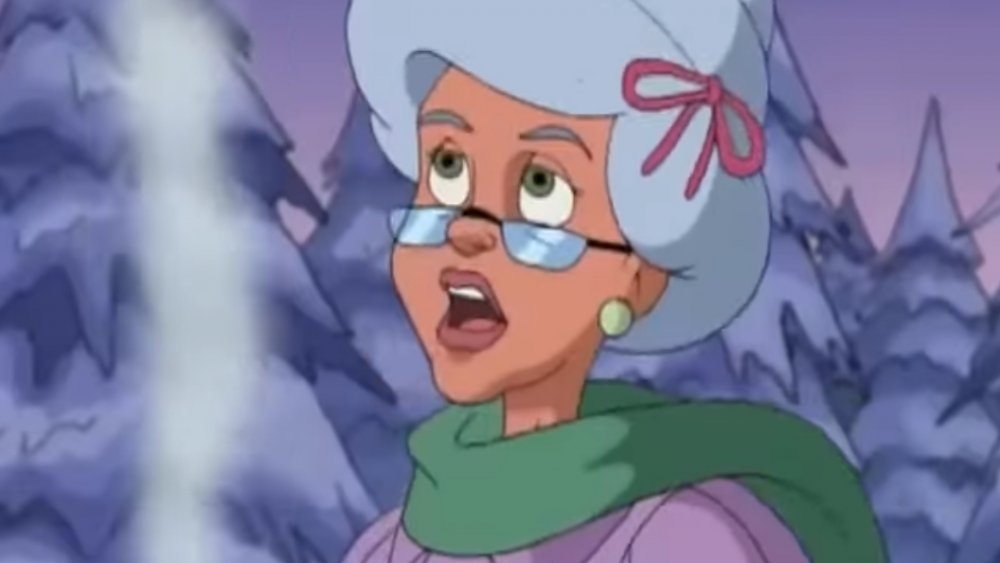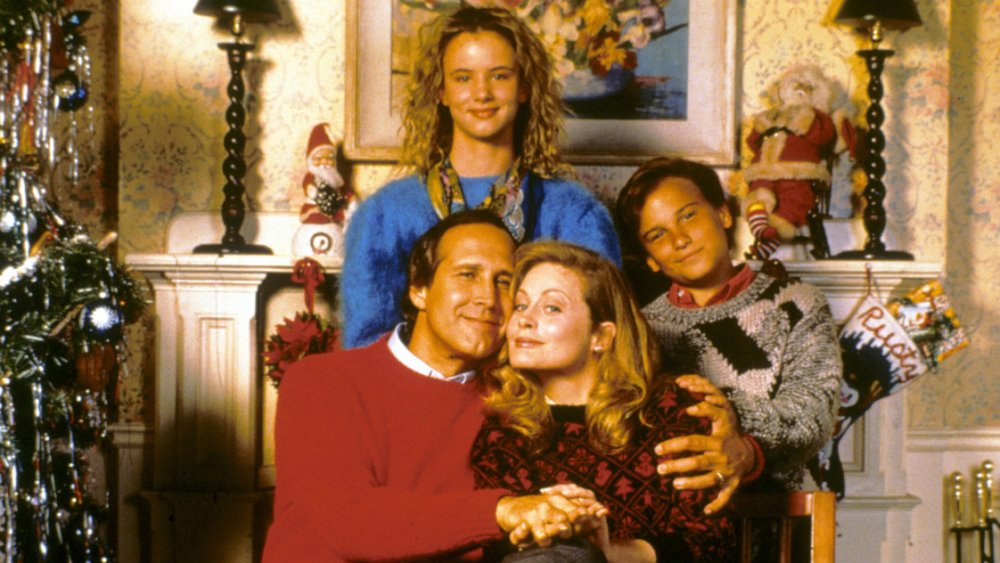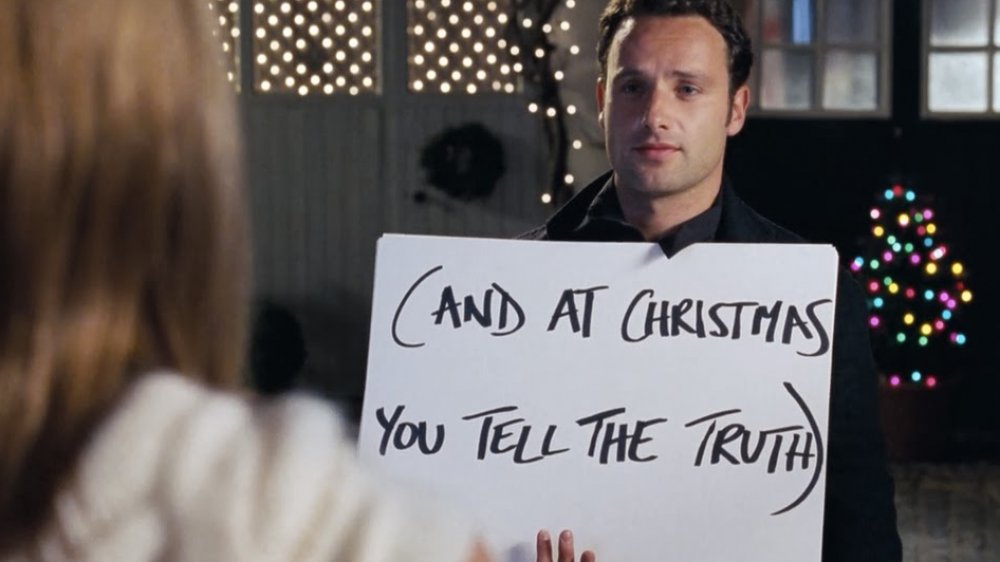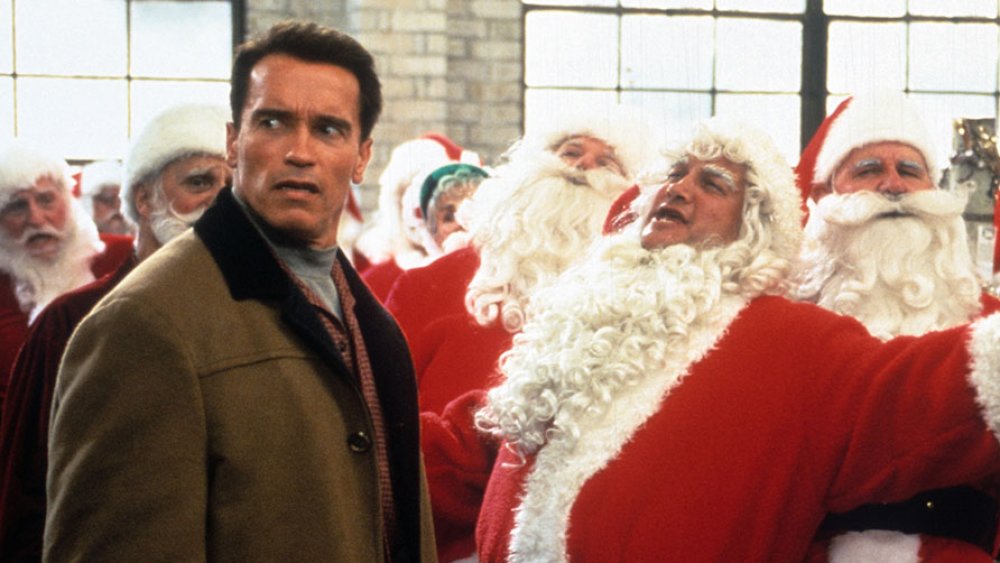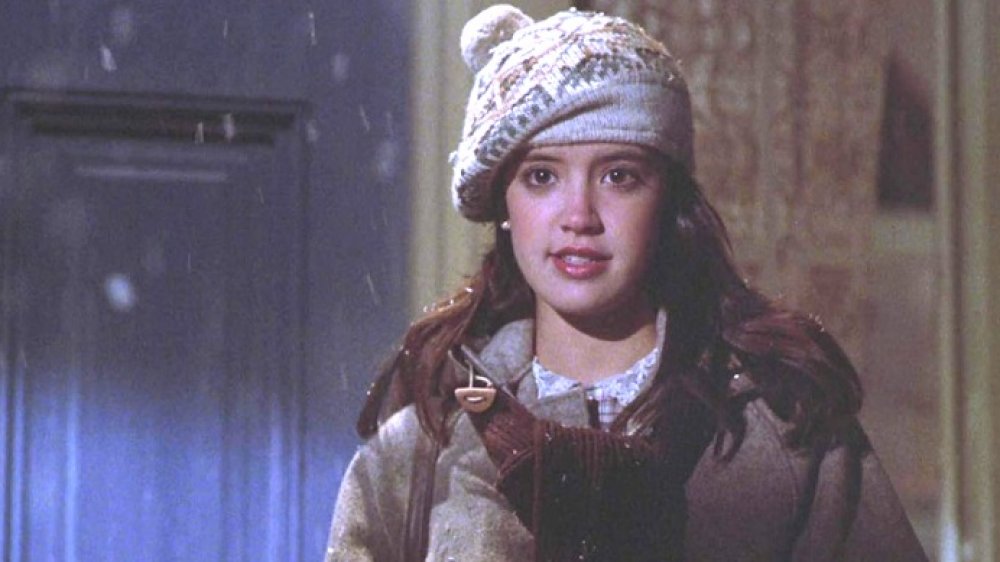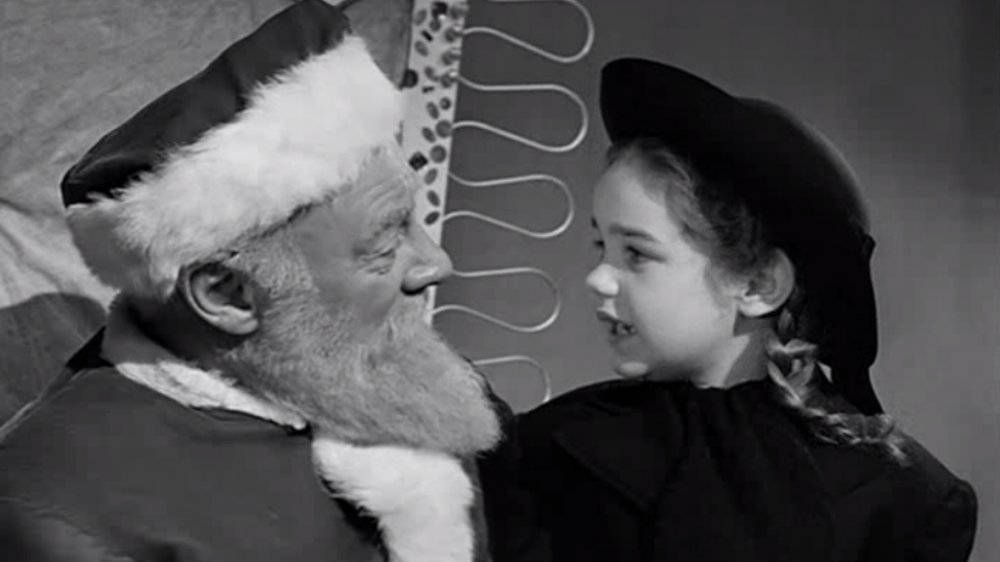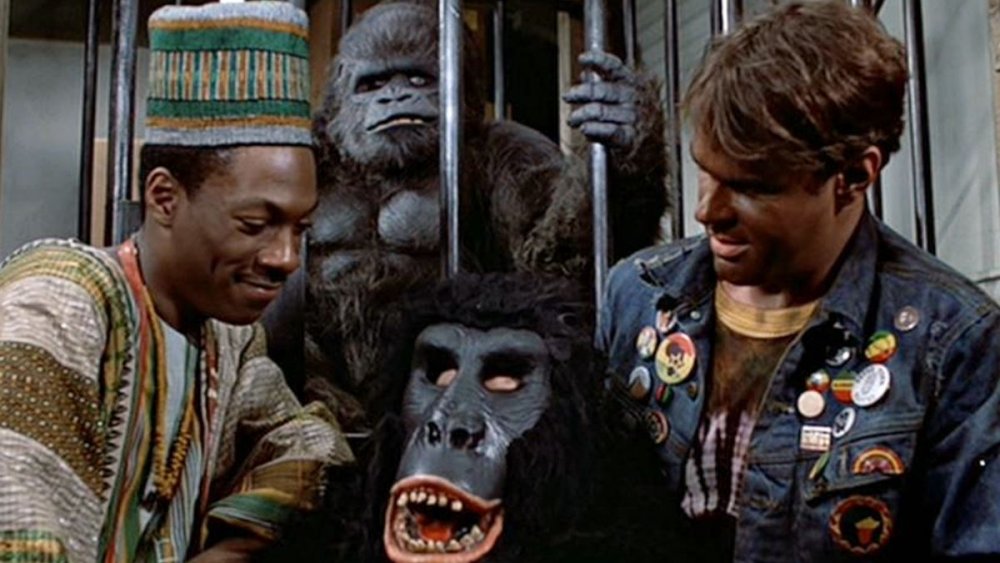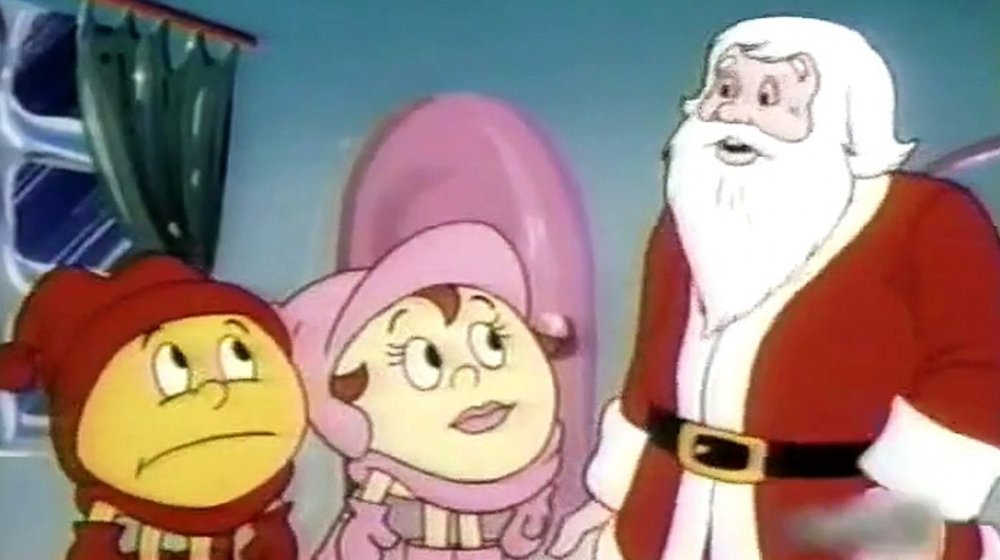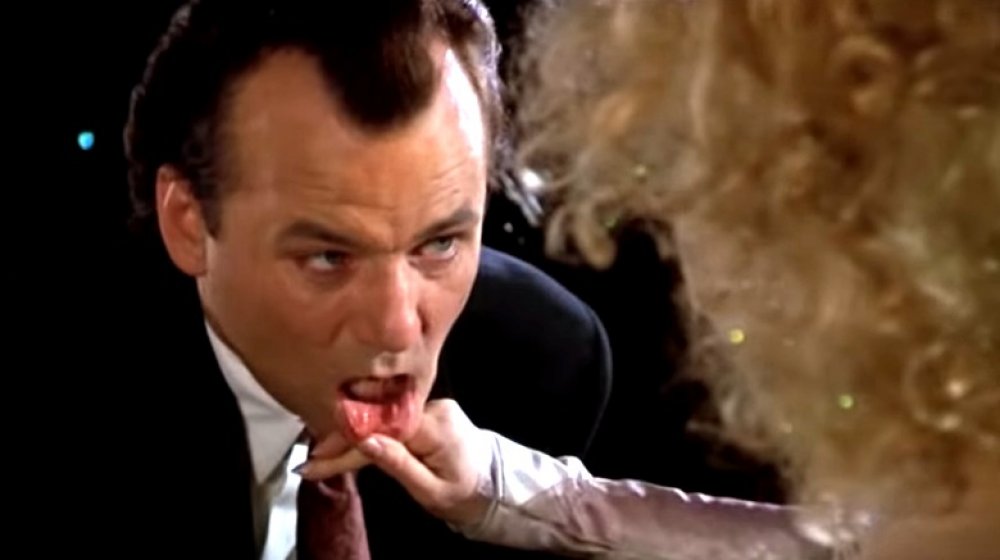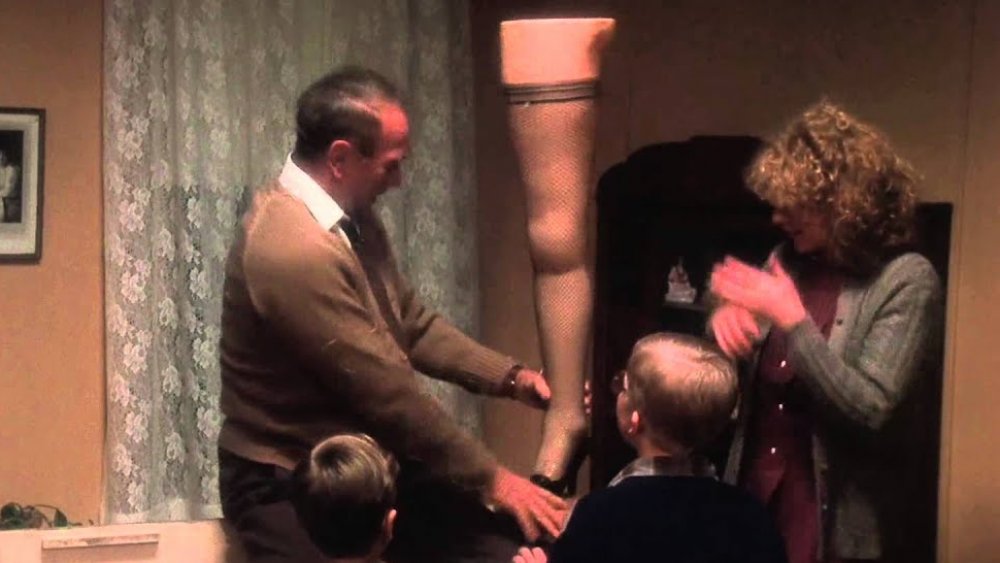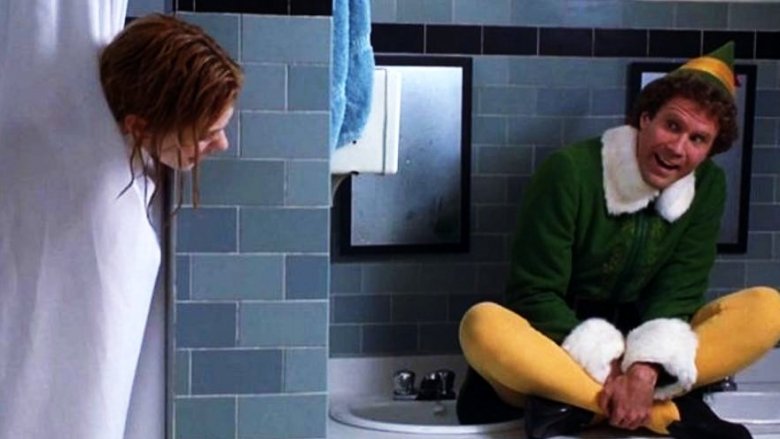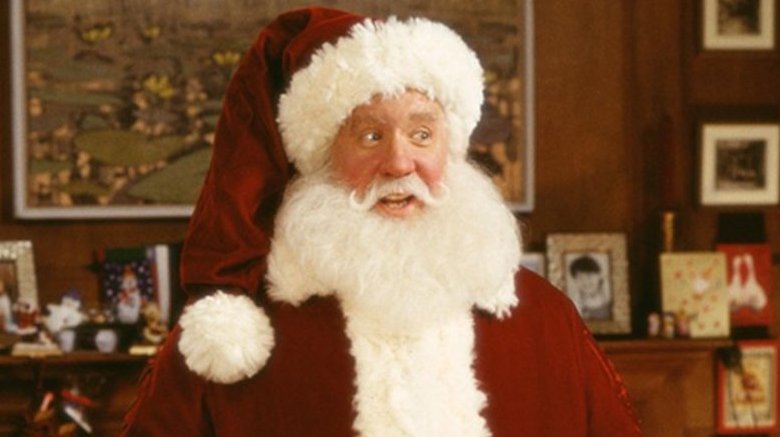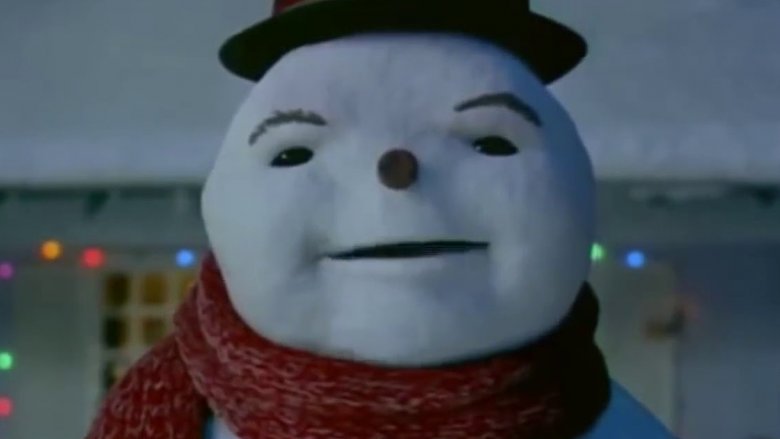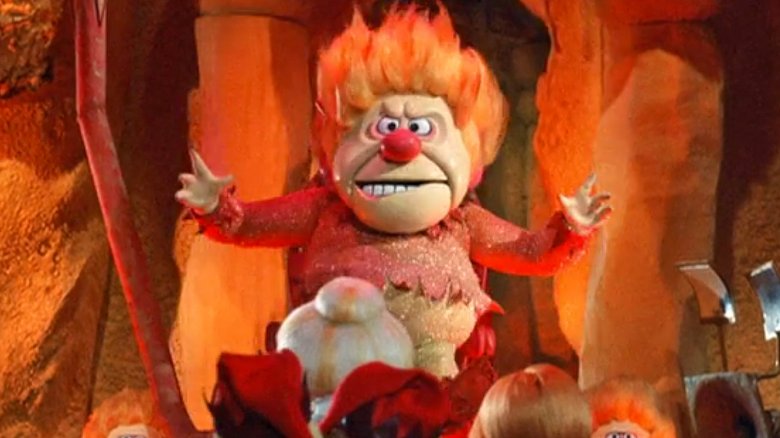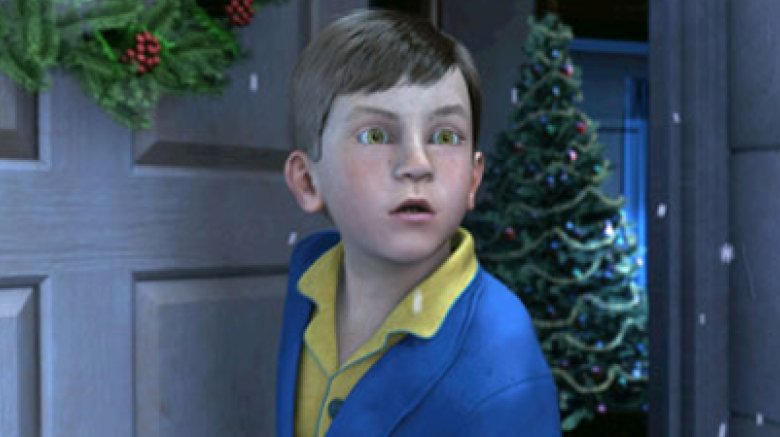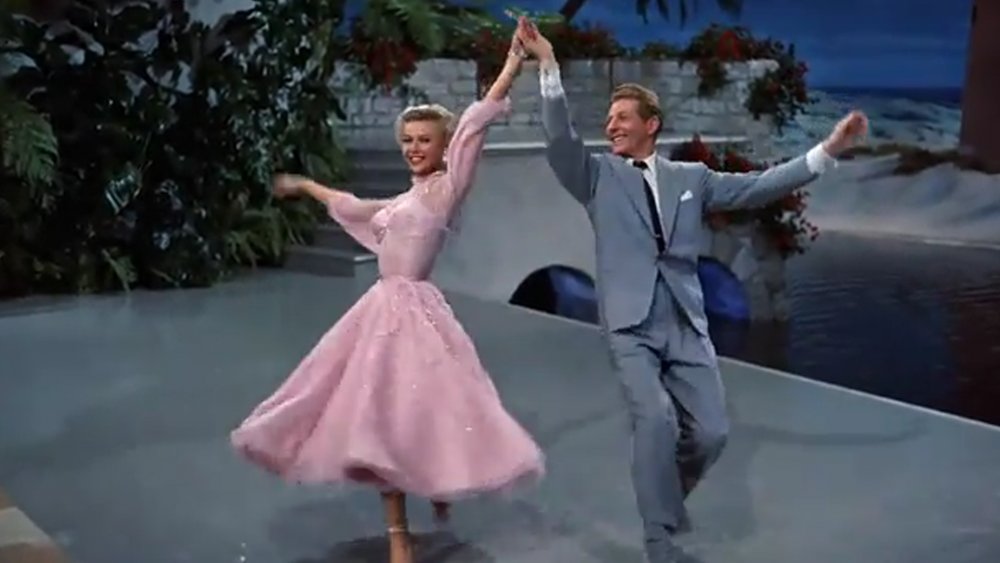The One Messed Up Thing About These Christmas Movies Nobody Talks About
Nothing brings joy and relaxation like a wonderful Christmas movie. Of course, one man's "Christmas movie" is another's "they mentioned Christmas so it counts." Whether you agree or not, what's undeniable is that you've probably seen these movies eleventeen times but never really processed some of the strange details. Once you notice these you'll never unsee them.
Frosty The Snowman: Frosty stole the hat
If you're walking down the road and your hat blows off, the first person who finds it doesn't get to keep it. So if you happen to be building a snowman and a hat comes bouncing down the street — via rabbit (just go with it) — you have no legal right to place said hat on your snowman. Even if it causes the snowman to come to life. But that's exactly what happens in Frosty The Snowman.
The old adage "possession is nine-tenths of the law" is adorable but also not true. As a G Texas court found (as summed up in English by US Legal), "Mere possession and whatever right to the property that comes with mere possession does not grant the possessor rights in the property superior to those of the actual owner." That means Professor Hinkle is the rightful owner of the hat, not Karen, the little girl who put the hat on Frosty.
If your retort is, "Well, Hinkle threw the hat away so he loses legal possession," you're almost right. It is perfectly legal to dumpster dive, but Hinkle never threw away the hat. He merely insulted it and tossed it. It never entered the trash. The hat belongs to Hinkle, and Frosty is a fraud.
Rudolph The Red Nosed Reindeer: Yukon Cornelius
There are a bunch of little things you might pick up during the claymation classic Rudolph The Red Nosed Reindeer, like how there's a reindeer missing when Rudolph leads the sleigh, or how Donner is going to have to delete his Twitter after telling his wife that searching for Rudolph is "man's work." It's worth noting that Mrs. Donner and Clarice went out looking anyway, so we know who wears the antlers in that family. But all that stuff pales in comparison to the big Bumble in the room: Yukon Cornelius.
The great Yukon is in search of silver and gold (you just sang that, you know you did). He's obsessed with the stuff, to the point where he tosses his pickaxe into the air and uses it as some divining rod to try and locate it. How does he know if he's found it? He licks his pickaxe. If it feels like that statement needs a "Phrasing!" after it, that's because it does. Not once does Rudolph, Hermey, or anyone else ask him why he's doing that, or what silver or gold exactly tastes like. When you realize he even licks his axe on an iceberg you know something's weird here. Originally, Cornelius was looking for a peppermint mine, but everything that could explain that has been cut from the movie since it was first aired on TV. Now Cornelius is just a weirdo trying to figure out what silver and gold taste like.
A Charlie Brown Christmas: The fate of Charlie Brown's sad tree
A Charlie Brown Christmas is justifiably considered one of the all-time greatest Christmas specials. Since originally premiering, it's aired every single holiday season for over 50 years, and it's easy to see why. Charlie Brown grappling with wintry depression is something that many viewers can relate to, and the themes of losing the message of peace on Earth and goodwill to men underneath an overwhelming tide of commercialism are still relevant today.
It even manages to be so well-crafted that a climax where someone literally steps into a spotlight to read Bible verses about the birth of Jesus doesn't feel heavy-handed or preachy, even if Linus does come off a little smug about it. The only problem is that poor, pathetic Christmas tree. Not because of the tree itself, you understand. In fact, if you're going to go as far as having someone straight up read the Book of Luke to you, you couldn't ask for a better metaphor for a child born unto a carpenter in the humble surroundings of a manger who would grow up to bear the sins of man than a tiny, unappreciated sapling, unable to support even a single crimson bauble.
And yet, when the Peanuts gang finally does come to appreciate Charlie Brown's tree, it's not for the tree that it is. Instead, with a wave of their hands, they pretty it up into a standard-issue Christmas tree, covered in shiny garlands and bright lights. In short, they took the perfect metaphor for the true meaning of Christmas and made it more commercial.
It's A Wonderful Life: Bury those dreams
There may not be a more beloved Christmas movie than It's A Wonderful Life. It's a story of hope, faith, and how to bury your dreams. Wait, what? It's very easy to overlook exactly how George Bailey got into his predicament. Sure, the simple answer is the bank run and people not understanding how banks actually work, but there's a much more sinister reason ol' George got there in the first place.
As The Atlantic points out, George gave up his dream of traveling around the world to run the bank. That's right, by not following his dreams, he got stuck in a nowhere town where a panic almost cost him his life. George even had a chance to pass on his dead end job to his brother, but unlike George, Harry secured a great job in a big city (Buffalo), so George was stuck in little Bedford Falls. The real lesson of It's A Wonderful Life isn't faith and hope and love, it's "Follow your dreams or you might get stuck in Nowheresville."
Grandma Got Run Over By a Reindeer: Grandpa did it
The animated movie based on "Grandma Got Run Over By a Reindeer" — which, weirdly enough, originally aired on Halloween — plays the content of the song relatively straight. Sure, they do it in the weirdest way possible, with Grandma herself going missing and living at the North Pole as an amnesiac while the rest of the family assumed she was dead, but there was, in fact, a Santa Claus, complete with a reindeer that trampled the poor matriarch into a concussion. As weird and unappealing as its narrative might be, it's certainly festive.
The original song, on the other hand, might be the single greatest example of a narrative completely changing once you get older and genuinely listen to it, and the fact that someone actually decided to make a children's movie about this thing is downright demented. The best-case scenario is that if you take it at face value, you've still got a song where Santa Claus, the saintly gift-giver beloved by children all over the world, committed vehicular manslaughter. Make no mistake, in the second verse of that song, where everyone's dressed in black, that lady is dead.
Once you realize that the child telling the story is an unreliable narrator and start digging deeper, a more sinister revelation emerges. It's especially evident in the original music video, where "Cousin Mel" is an attractive young lady who hopefully got into the family by marriage rather than blood, but the lines about how happy Grandpa is after Grandma's death lead inevitably to one conclusion: he murdered his wife on Christmas Eve. Those "incriminating Claus marks on her back" are the sign of a struggle, and the only reason he's taking it so well is that the entire family has agreed to cover for him by blaming it on Santa. That's not the plot of a movie for kids, folks. That's the plot of an issue of The Punisher.
Christmas Vacation: Clark and Ellen's miserable marriage
For people who dread seeing their relatives over the holidays, National Lampoon's Christmas Vacation is a comedy classic, but there's something at the core of the story that makes the whole thing seem more than a little sad. The fact that Clark Griswold (Chevy Chase) is a pretty terrible person is obvious from, well, pretty much every frame. The entire plot, after all, is driven by the fact that he's been spending money he doesn't have in an effort to be a big shot, and most of the comedy comes from the sheer, seething hatred that bleeds out in the form of one-liners at the expense of his extended family.
Unfortunately, that familial misery seems to extend to his marriage, too. When Clark heads to the store to buy a present for his wife, he encounters the beautiful Mary, and almost falls over himself with the desire to cheat on his wife. The fact that he's fantasizing isn't the problem — Nicolette Scorsese circa 1989 hiking up her skirt is enough to provide a distraction for a lot of people — but when his Freudian slip goes straight to "adultery," there's probably a bigger problem there.
Later, when he's fantasizing about how sweet life will be once he owns the pool, Mary shows up in his fantasy to do a swimsuit striptease on the diving board, which also involves all the relatives vanishing from both the pool and, presumably, his life — including Ellen. Again, the fantasy's understandable, but Clark mentally sorting Ellen into the same group as Cousin Eddie (whom he flat-out hates), is a pretty strong indicator that things aren't going well at the Griswold house. And that's before you remember that there's precedent for it — in the original Vacation, Clark goes skinny-dipping with Christie Brinkley after flirting with her on the highway, and is only stopped from cheating when he's interrupted by his wife.
And the worst part? Despite her happy face and the fact that she manages to keep it together through at least five movies, Ellen is absolutely aware of how much of a sham her marriage is. When her daughter complains about having to share a bed with her brother due to the family staying at the Griswold house, referring to it as "sick and twisted," Ellen's response is "Well, I have to sleep with your father." Yikes.
Santa Claus: The Movie: Let's watch Santa die
On paper, Santa Claus: The Movie is a slam dunk. It's the story of Santa Claus from the producers who brought Superman to the big screen in 1978, making audiences believe that a man could fly. In practice, though, it's a mess. Rather than focusing on Santa, the plot is mostly concerned with an elf named Patch teaming up with an evil toy company executive to create a new holiday in March called "Christmas 2" as an advertising stunt. Because, you know, that's what the kid are into: stories about the fast-paced world of marketing.
The worst part, though, is the origin story that it presents for Jolly Ol' Santa. Rather than explaining his seeming immortality as the product of Christmas Magic, this movie posits that Santa is able to stick around because he's already dead. In fact, the first thing that happens in this movie is that children are invited to watch Santa and Mrs. Claus die of exposure, freezing to death in vivid technicolor.
What's worse, this set a bizarre trend of movies that ask children to watch Santa Claus die — it's also the first thing that happens in Tim Allen's alleged classic, The Santa Clause. To be fair, though, that movie doesn't labor under the impression that kids are really into marketing. Instead, it offers up a thrilling look at everyone's favorite part of Christmas: contract law!
Love Actually: That's not a thing
2003's Love Actually is well known for featuring a variety of takes on Christmastime love that range from the genuinely sweet (Jamie learning Portugese to confess his love for Aurélia and Billy Mack learning that the real Christmas was the friends he made along the way) to the hilariously sex-charged (John and Judy finding love while acting as body doubles for a sex scene and Colin flying to Milwaukee for an international orgy) and all the way to the heartbreaking (Harry's near-infidelity with Mia). But even stacked up against all those, the most memorable storyline in the entire film, for all the wrong reasons, comes from Peter, Juliet, and their pal Mark.
If you've managed to miss out on seeing it, the basic story is that Peter (Chiwetel Ejiofor) and Juilet (Keira Knightley) get married, but Peter's best friend Mark (Andrew Lincoln) is extremely cold to her, to the point of not actually giving her the video he shot at the wedding. Eventually, she learns that the video is full of long, lingering close-ups of her and basically no footage at all of Peter because Mark's been nursing a crush. Eventually, Mark shows up at Juliet and Peter's house, tricks Peter into thinking there are carolers at the door, and confesses his love to his best friend's wife with an elaborate series of cue cards that include a photograph of a desiccated corpse.
Of course, that scene overall has probably been discussed to within an inch of its cinematic life, but one piece of it is often missed while people are talking about what a creep Mark is. Early in the confession, he holds up a card reading "at Christmas, you tell the truth," and as comedian Paul F. Tompkins pointed out, that's not a thing.
Now, honesty is generally a pretty good policy that'll keep you from winding up with a lump of coal, but nobody ever sits down and says, "Well, it's Christmas, time for the annual tradition of telling the brutally honest truth again!" Lying isn't even mentioned as one of the things you better not do before Santa Claus comes to town — and in fact, Santa himself is the one big lie that we all agree that it's okay to tell on Christmas itself!
Jingle All the Way: Howard's neglected, crumbling marriage
Jingle All the Way is, to say the least, a pretty weird movie. Based on the idea of Christmas shopping crazes and the hype surrounding each year's hottest, must-have toy, the movie undercut its own satirical point by actually rushing the fictional product to real-life stores just in case the movie was a big hit and kids wound up wanting a Turboman doll of their very own. They needn't have bothered.
In the film, though, Turboman — or as Arnold Schwarzenegger pronounces it, "Tyurrbuhmen" — is definitely a hot commodity. Arnold stars as Howard Langston, a father desperately trying to make up for years of broken promises by getting his son the sought-after toy for Christmas. In the process, he finds himself in what basically amounts to a life-or-death struggle with a postal worker played by Sinbad, who at one point makes a bomb threat against a radio station because that's the kind of thing people thought was hilarious back in the '90s.
Needless to say, Howard winds up getting the doll for his son in a scene that also involves a jetpack. The last shot of the movie, however, is Howard's long-suffering wife, who's disappointed in the way he neglected his family in favor of his job as a mattress salesman, asking what he got her. This leads to a comedy take from Schwarzenegger, but if the camera had stayed on that couple for five more minutes, audiences would've witnessed the complete dissolution of a marriage, and a conversation about whether they could stay in their loveless union until Jamie left for college.
Gremlins: Don't watch it with little ones
If you're in the mood for a little '80s nostalgia, Gremlins seems like a nice choice for family movie night. If you haven't seen it in a while, you probably remember Gizmo and some crazy violent stuff with the gremlins and some people, but nothing the kids couldn't handle, right?
Well, for starters, as History points out, the PG-13 rating didn't debut until a few months after the the June 1984 release of Gremlins. But it's not the ultra violence or gremlin in a blender that kids shouldn't see, it's the other big big spoiler that they ... um ... unwrap. If you don't remember Phoebe Cates characters' motivation for hating Christmas, she spells it out, with the clearest language that even an elementary school student could understand. Her father died in a horrific accident, and also that's how she found out Santa Claus wasn't real. Ooooooof. Don't be fooled by the PG rating and the cute Mogwai; this ain't for the littles.
Miracle On 34th Street: How's your Dutch?
Miracle On 34th Street and It's A Wonderful Life both share the universal message of faith and hope, only 34th Street also conveys the touching edict that the U.S. government can make anything legal just by sending it a letter. Outside of that last thing, the movie is actually a super-positive flick that brings a smile to your face the entire time, right? Well, not entirely. One little part would slip by about 99 percent of Americans today.
Early in the film, Kris Kringle meets a young girl missing her two front teeth. The adult with her explains that the girl speaks Dutch only because she was an orphan in Rotterdam who recently arrived in the United States (compliments of the nice lady who adopted her). Director George Seaton went all Francis Ford Coppola 25 years early and didn't translate the Dutch spoken by the girl and Kringle. So what did the girl ask for? Two front teeth? A pony? According to Destination Hollywood, she asked for nothing. "I don't want anything, I already have everything, I just want to stay with this lovely lady." It's cute, it's nice, but if you actually know Dutch, it could be a bit of a mood-breaker. "Santa is real, but here's a sad orphan thing going on!" If you don't know Dutch, at least Santa does.
Trading Places: A guy and a gorilla...
If you don't think Trading Places is a Christmas movie, that's on you. What do you think all the lights are there for, Arbor Day? Eddie Murphy's career took off after Trading Places, and Dan Aykroyd used it to relaunch his career after two stinkers (Doctor Detroit and Neighbors). There's a lot of zany stuff, plus stock manipulation (which was legal at the time), but there's one scene that you should remember but probably don't.
Late in the film, Murphy, Aykroyd, et al are about to be foiled on a train by the Duke brothers' muscle. And there's a gorilla on the train because if you can think of a better way to transport a live gorilla than a passenger train the world is listening. As luck would have it, a passenger on the train (played by Jim Belushi) enters the train car in a gorilla suit as the Deus ex machina, hijinks ensue, and the bad guy gets knocked out, thrown in the gorilla suit, and put in the cage with the real gorilla.
Later, two baggage handlers come in and agree to allow the two gorillas to have some fun since it's New Year's Eve. They figure one of the gorillas is the female, but it's actually the human one. Because what's a Christmas film without a little humorous sexual assault? By the way, one of the actors who played a baggage handler that let the assault go forth? Future U.S. Senator Al Franken.
Christmas Comes to Pac-Land: Pac-Man exists beyond the sight of God
Not every Christmas special can be as beloved as Rudolph or Charlie Brown. Take, for instance, Christmas Comes to Pac-Land, the 1982 tie-in to the Pac-Man animated series. As you might expect from a cartoon tasked with building a narrative from a game about eating dots in a maze while being hunted by ghosts, the series took a lot of liberties with the source material, and when it came time to talk about Christmas, they accidentally revealed something truly harrowing about Pac-Man and his world.
It's a pretty simple plot: After getting into a high-speed chase where they're almost murdered, Pac-Man and his family encounter Santa Claus, whose sleigh was brought down in a midair collision with the ghosts as they flee the scene of the car crash. With Santa and the Reindeer injured, Pac-Man has to go searching for his bag of toys and cure the reindeer by feeding them the glowing orbs that give him the ability to devour ghosts. He does, and Christmas is saved. Simple.
The weird part, if this thing can be said to have only one weird part, is that Pac-Man, his family, the ghosts, and all the other residents of Pac-Land have no idea what Christmas is. That's not that unusual in and of itself. He-Man & She-Ra: A Christmas Special from a few years later also features characters who need to have Christmas explained to them, but Eternia is in another dimension. Considering that Santa is able to fly there on Christmas Eve, Pac-Land has to at least be Earth-adjacent. Start thinking about it, though, and the answer becomes clear: a place that only a Saint can travel to, full of people defined by gluttony, where the souls of the dead can't leave and must remain as ghosts, and where no one has ever heard of Christmas or Jesus Christ? Pac-Land is Hell, folks, where damned souls must toil in a never-ending maze.
Scrooged: Bill Murray wasn't faking it
Bill Murray is a bit of a legend in modern society, a guy you'd love to run into at a bar or a Cubs game and just pal around with. But in the mid- to late '80s, he was more of an ensemble actor, a funny guy who couldn't carry a film himself. Murray is known as a fellow who takes his movies very seriously, which has led to a few run-ins with fellow actors (and friends). There's probably a long list of people who'd love to pop him in the kisser.
A retelling of the Charles Dickens classic, Scrooged puts Murray in the Ebenezer role as Frank Cross, a modern (well, 1988) daytime TV producer. The rest of the story unfolds as a comedy-drama that surprisingly works. Naturally, Murray must run into three "ghosts" to help him deal with his issues. Carol Kane plays the Ghost of Christmas Present, and spends her time mostly flying around on a rope and smacking the stuffing out of Murray. According to Mental Floss, Murray encouraged Kane to hit him, and she sure did. In one scene, Kane grabs Murray's lip. Murray gives an uncomfortable look and moves his tongue to the bottom of his lower teeth. You know that little piece of skin between your gums and lip? That's called a frenulum, and Kane tore Murray's. Filming paused for a bit while Murray healed, but at least they finished the scene.
A Christmas Story: The dirty joke that wasn't
There are so many quotable lines from A Christmas Story that to this day you probably still claim something is Italian because it's "fra-jee-lay." It's a classic scene, and deep down inside a lot of you probably want a leg lamp. There's a subtle little joke right there on the box that most everyone missed.
As the delivery fellas bring the "major award," above the Italian trademark, it clearly reads, "His End Up." What? Given that there's a sexy leg lamp inside the box, is this some super dirty joke in a kids movie? That movie's run on TBS how many times a day for 30 years? Hey, get your mind out of the gutter, you slimeball! The News Herald reports that rather than a crass line, it's simply a production error; the original box was too long to fit through the door so the production team trimmed it; it was about one "T" too wide. It wasn't a dirty joke, just a big box.
Elf: Arrest that giant elf
Elf is a delightful film, a modern-day entry into the all-time canon in large part due to Will Ferrell's performance as Buddy, the human raised by Santa's elves who maintains a hardcore obsession with all things Christmas as well as a childlike innocence. Well, those factors may be what drive him to decorate a whole floor of a department store overnight and congratulate a diner on its actually crummy "world's greatest coffee," but also Buddy is a full-grown man with urges he acts on in an alarming, even illegal way.
Buddy's little crime is actually presented as just another way he loves Christmas culture. He's got a major crush on department store elf Jovie (Zooey Deschanel) and he sneaks in to the women's showers at work to listen to her sing "Baby, It's Cold Outside." Before long, he joins in on the duet rightfully freaking out Jovie, because she thought she was alone ... in the showers, naked and vulnerable. And Buddy seems mystified as to why she's so mad, as if he doesn't know that showers are a place for nudity. He's shown showering earlier in the film, so he definitely hit the showers to sneak a peek, the creep.
The Santa Clause: An industry of death
About 90 percent of The Santa Clause is about Tim Allen discovering the real meaning of Christmas by slowly transforming into the actual Santa Claus and witnessing pure, close-up holiday magic, with flying reindeers and toy-making elves and so on. But it starts out with some of the darkest Christmas movie stuff since George Bailey tried to kill himself in It's a Wonderful Life. First, there's a scene where divorced workaholic dad Scott Calvin (Allen) takes his son out to a holiday meal at a stark little Denny's that has several other sad, divorced dads and their children. Then the real holiday tragedy kicks in. The whole film is predicated on Scott becoming Santa because he startles the real Santa on his roof, causing Old St. Nick to slip and fall to his death. Scott puts on the suit and becomes Santa for at least three whole Santa Clause movies' worth of time.
You had to have noticed the death — it's the point of the movie — but this is really saying something about the Santa Claus mythology. This changing of the guard suggests that Santa is not one immortal person but rather a title, held by a succession of regular individuals who don the magical suit. And each individual becomes Santa after killing off the previous Santa Claus. It's a chain of endless ho-ho-homicide stretching back for who knows how long, and which will continue when someone murders or accidentally kills Scott Calvin. Reboot? In fact, Tim Allen has even said that in earlier versions of the script he was supposed to mistake Santa for a burglar and shoot and kill him. Now that smells like a reboot.
Jack Frost: A chilling premise
There are few things worse in the life of a child than the death of a parent, but one of them is definitely the death of a parent on Christmas. It's an unspeakably sad thing, and parents reading this right now probably pictured that all going down and set off to go give their kid a hug and then take their Lipitor. It's certainly too sad to ever make a movie about a guy who ruins Christmas forever for his kids by dying on that day ... right? Nope, in 1998, Michael Keaton played a dead patriarch in Jack Frost. But good news: It's a wacky family fantasy movie because he doesn't stay dead long — he returns to life as a poorly visually rendered, magical talking snowman with the voice of Michael Keaton. (Staying dead might have been the better option.)
Keaton's character (at first) is a guy literally named Jack Frost, as in the mythical character that personifies winter, a middle-aged musician who fronts a bluesy bar band. (It's the role Bruce Willis was born to play!) Shortly after giving his favorite harmonica to his son, he gets in a fatal car accident in the middle of a snowstorm while trying to get home to his family for Christmas. Happy holidays, everybody!
A Year Without a Santa Claus: Sad Santa
If you don't count Rudolph the Red-Nosed Reindeer, then A Year Without a Santa Claus is the best stop-motion animated Christmas special ever made by Rankin/Bass Productions. But it's also pretty bleak. It first aired on American television in 1974, the year President Richard Nixon resigned and while the Vietnam War still dragged on. The resultant cynicism and psychic fatigue felt by millions of Americans shows in A Year Without a Santa Claus.
Our story begins with a bedridden Santa Claus, who his doctor believes has literally worried himself sick with the notion that nobody cares if he even exists. The sad sack with the toy sack decides to sit out a Christmas, while Mrs. Claus sends out some elves (Jingle and Jangle) to find some true believers. They set out on their journey with reindeer Vixen ... who gets shot down in the crossfire from the weather-controlling Miser brothers: Snow Miser, and Heat Miser, a demonic presence who lives in a fiery land that resembles every artistic rendering ever of Hell. Sure, it all ends well and Santa gets better, but that's after a sour tone was set with depression, illness, violence, and hell-spawn.
The Polar Express: Hey, kid, get on the train!
Based on a beloved, and fabulously rendered, picture book by Chris Van Allsburg, The Polar Express takes viewers, and the main character (called, ugh, "Hero Boy" in the credits) on a magical Christmas journey. Our Hero Boy doubts Santa is real, only to be awakened on Christmas Eve by a massive, old-timey steam train outside his front door. The conductor (a motion-captured Tom Hanks) announces that this vehicle is the North Pole-bound Polar Express (you know, where Santa lives). Based on this flimsy, unbelievable premise, Hero Boy readily boards ... in the middle of the night ... without telling anyone. Merry Christmas, Hero Boy's mom and dad: Your gift this year is a missing persons case.
Of course, this is to say nothing of the fact that The Polar Express takes place in a world where not only Santa is real, but also in the Uncanny Valley, where everybody looks both too real and incredibly unreal. Who knew Tom Hanks could be so creepy?
White Christmas: They're doin' choreography!
Say what you will, but White Christmas is a movie that gets a whole lot done. It's got two romances, a plotline that addresses the difficulty of military men fitting back into civilian life, a story built around people coming together to help each other out at Christmas that never fails to bring a tear to the eye, and two — two! — performances of the best-selling song of all time. And yet, it still makes time for Danny Kaye to really lay into all the incomprehensible and apparently infuriating modern dance trends that were threatening to ruin theater in 1954.
Most of the songs in the movie, from the charming "The Best Things Happen While You're Dancing" to the hilariously abysmal "Snow," have to do with the movie's themes. "Choreography," on the other hand, comes out of nowhere, with Kaye leading a troupe of dancers through a parody of these newfangled beatnik ideas, complaining about how the chicks who did kicks aren't kicking anymore until he's interrupted by Vera-Ellen and the large-toothed, eternally silent avatar of dance, John Brascia, who arrive with rapid-fire tap-dancing to show these damn kids how it's done. Of all the songs in the movie, that one's the weirdest.
Well, that one and the one where they talk about how much they miss minstrel shows, but a lot of people talk about that thing, and most of us just wind up skipping it.
